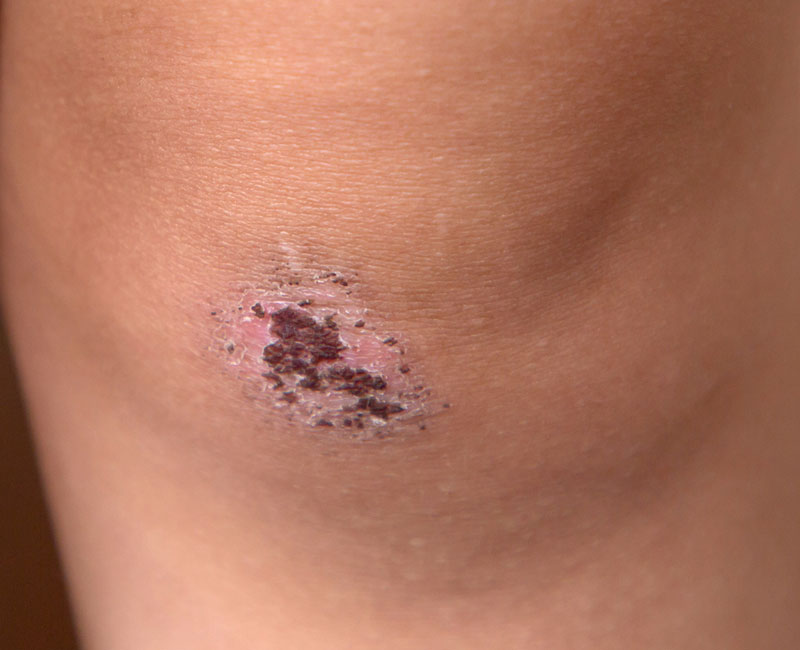A scab is your body’s way of protecting a skin wound. It stops bleeding and works as a shield to prevent germs from getting into the wound. There are certain steps you can take to make sure a wound with a scab heals well.

A scab is a hard, dried blood clot that can form over a cut or broken skin to stop bleeding and protect the tissues underneath from germs. A scab is a part of wound healing, but not all wounds result in scabs.
Healthcare providers may call scabs “crusts.”
Advertisement
Cleveland Clinic is a non-profit academic medical center. Advertising on our site helps support our mission. We do not endorse non-Cleveland Clinic products or services. Policy
A scab has two jobs:
A scab is essentially a blood clot on the surface of your skin. When your skin experiences damage — like a cut or scratch — and it bleeds, a blood clot forms to stop the bleeding. After some time (a matter of seconds or minutes), the blood clot dries. This is a scab.
A scab also protects an injured area from germs and other irritants that could cause a skin infection or interfere with the healing process. You can think of a scab as a mini shield. It’s the wound’s first form of defense against invaders. It’s also hard like a shield.
Scabs generally remain firmly in place until the skin underneath heals and new skin cells appear. Once your skin has properly healed, your body no longer needs the scab — it eventually falls off.
While scabs are good at protecting damaged skin, they can actually delay wound healing compared to wounds that don’t form scabs. The quickest way to heal these injuries is to clean them, keep them moist with petroleum jelly and cover them with a bandage. This strategy may also lower your chances of developing a scar.
Scabs can form when you have a skin wound — typically one that bleeds. A skin wound results from the breakdown of the epidermis (the outer layer of your skin).
Scabs usually develop when a skin wound remains dry. If the environment around the wound stays moist (such as with antibiotic cream or petroleum jelly) and protected, a scab may not form.
Scabs may develop from the following wounds:
Certain skin conditions can lead to scabs if your skin breaks open. Examples include:
Advertisement
A scab is a dried-up blood clot. It’s a combination of:
Sometimes, a scab may have tiny fibers in it, like small hairs or clothing fibers. This can happen if they stick to the blood before it dries completely and forms a scab.
Scabs are usually dark red or brown. The color can lighten as the wound heals and new skin under the scab develops. But scabs can be other colors for certain reasons:
Advertisement
Scabs may itch as a natural part of the healing process. Your body releases certain cells (like histamine) when you experience an injury. This can cause inflammation and itchiness. Dry skin around the wound and scab may also cause itchiness or make the itchiness more intense.
Try your best to avoid scratching a scab and the area around it. If you break open your skin again, it can slow down the healing process and increase your risk for infection. If you have excessive itchiness, talk to your healthcare provider.
Signs that a wound with a scab is infected include:
See your healthcare provider if you develop these symptoms. You may need an antibiotic to treat the infection. You may also need medical wound care.
Certain factors and conditions can prevent wounds with scabs from healing or slow the process, including:
Call your healthcare provider right away if you have:
In general, it takes at least a week for a wound with a scab to heal and no longer need a scab to protect it. But several factors can affect this, like the size of the wound and if you have underlying conditions that make your body’s healing process slower.
Wounds typically heal faster when you keep them moist with a wound care cream or petroleum jelly compared to if you leave them dry. Moisture helps new skin cells form and repair the wound.
This may also apply to scabs. Keeping a scab moist with petroleum jelly and protected with a bandage may help the wound heal faster than if you leave the scab dry. Whether the scab is dry or moist, it’s important to make sure it doesn’t peel off prematurely. A bandage can help prevent this.
Keeping the wound and scab clean also helps prevent infection, which slows down the healing process.
You shouldn’t peel or remove a scab because it can slow down the healing process. When you prematurely remove a scab, you’re also removing some of the newly formed skin tissue growing underneath.
In addition, if you peel a scab, the revealed skin may be red and oozing. This can cause a new scab to form. The more a wound has to form new scabs, the more likely you’ll develop scar tissue.
Lastly, when you remove a scab, you’re taking away your body’s shield against unwanted invaders, like germs. This can make you more vulnerable to an infection.
A note from Cleveland Clinic
Scabs — we’ve all had them. Although they can sometimes look kind of gross or be annoying, they’re an important part of the healing process. Try your best to keep your scab intact and take care of your healing wound. If you develop signs of an infection or your wound isn’t healing, see your healthcare provider. They can recommend treatments to get you back on the healing track.
Last reviewed on 02/13/2024.
Learn more about the Health Library and our editorial process.
Advertisement
Cleveland Clinic is a non-profit academic medical center. Advertising on our site helps support our mission. We do not endorse non-Cleveland Clinic products or services. Policy